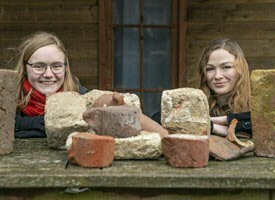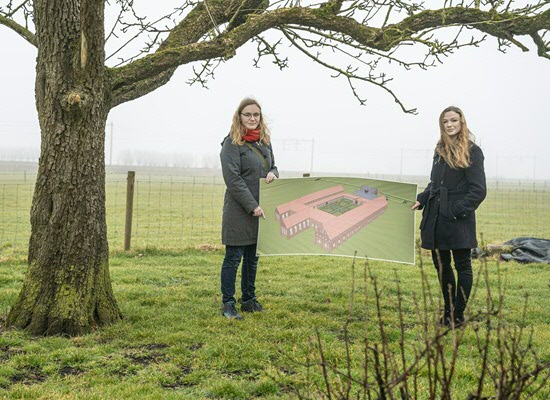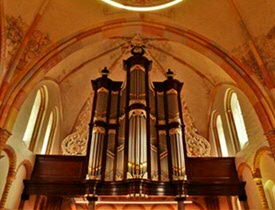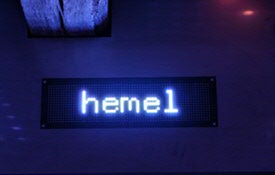Religious heritage: age-old culture in contemporary communities

Many people don’t have a clear idea of the importance of religious heritage. Student assistants Kjelda Glimmerveen and Loïs Bakker explain the situation – but they believe that young people can also develop an interest in heritage if you let them see and experience it.
The Network for Religious Heritage was launched in September last year. Why is this type of heritage important?
The Network wants to bring together museums, universities of applied sciences, research universities, church foundations and other heritage organizations in order to expand our knowledge of religious heritage and new developments. Thirteen organizations are involved, including the Stichting Oude Groninger Kerken and the Dorpskerkenbeweging in Groningen. This heritage is important in all kinds of ways. Churches and other religious buildings have a local significance, of course. They often play a vital community role in the towns, villages and neighbourhoods where they are located. But religious heritage is attracting greater attention at a national level, too. That’s because it’s part of our history, our culture and our national identity.

How can you demonstrate the importance of heritage to others, and to young people in particular?
That can be difficult because people often don’t have a clear idea of what heritage actually means. The term might conjure up vague notions of old museums or crumbling churches, whereas the great thing about heritage is that it still has an impact today. We believe that young people find heritage more interesting when they discover their own: family trees, family history, their own specific cultural mix. Of course, religious heritage can be anything: churches are religious heritage, but so too are religious rituals or stories. When young people discover this, it can create a spark and a realization that heritage can be interesting after all. Being shown and experiencing religious heritage can also arouse interest. Take them to churches, ones that are either still in use or repurposed, and to museums and archives. Of course, that won’t appeal to everyone, since people are interested in different things, but seeing and experiencing something makes a far greater impression than just hearing about it. There are all kinds of ways to actively engage young people in heritage.
What kind of research are you involved in yourselves?
Kjelda: I mainly do research on religion and fiction, but heritage often comes into that. At the moment, for instance, I’m looking at the Indiana Jones films and Dan Brown’s books, and exploring how Western characters interact with the heritage of other cultures.
Loïs: I carry out research on religion in medieval manuscripts, especially the relationship between Jews and Christians in Western Europe. Those manuscripts and their content are part of our heritage.

You’ve probably seen many great initiatives when it comes to repurposing religious heritage. What stands out for you?
Loïs: I always get very excited about bookshops in churches, like the ones in Zwolle or Maastricht. That’s because it brings together two of my favourite things: beautiful old buildings and books!
Kjelda: I’m also excited by bookshops in churches! And I’ve seen something I really liked in Veelerveen, where there’s a restaurant, 't Moment, in an old church. That means it’s still a meeting place and the beautiful architecture has been preserved, and yet it has a new purpose.
What does this mean for the villages and communities where you work? How are these projects received?
It varies across the different organizations, but the Stichting Oude Groninger Kerken, for example, only repurposes churches on the initiative of the villages themselves. It is important for the village to be involved and to make its own decisions because the local people are ultimately the ones who will have to maintain and use the building. Often, the village initiatives are already there, even if the building is still functioning as a church. In some villages, they ring the church bell at certain times and they commemorate the death of loved ones (a kind of All Souls’ Day). The building has a function for the community. The community is often happy that the church hasn’t been demolished and is still being used. On the other hand, there are conflicts at times: different parties have different ideas about what should happen – not everything is possible. You then have to come up with a compromise.

You’ll be graduating soon. What are your plans after that?
Kjelda: I’m in the first year of my Research Master’s, so it will be a while before I graduate! Just as well, because I don’t know exactly what I want to do next. A PhD appeals to me, because I’ve discovered that writing and doing research are what I’m really passionate about. But of course, I can also use these interests in other ways. Most of all, I’d like to continue to do new things and to keep using my creativity.
Loïs: I’m in my second and final year, so I’m pretty preoccupied with what to do next. I’m considering doing a PhD, too, but I’d also like to work in an archive, or some other organization that works with heritage. I did an internship last year at the Drents Archief, which I really enjoyed. I love researching old materials and finding a way to make them interesting for people today.
More information
Network for Religious Heritage, crh@rug.nl
| Last modified: | 04 January 2022 3.36 p.m. |
More news
-
15 October 2024
Focus op zingeving en leefstijl in de psychiatrie: Oratie Rogier Hoenders
Focus op zingeving en leefstijl in de psychiatrie met nieuwe leerstoel RUG
-
09 July 2024
As of September 2025 in Groningen: MA track Anthropology of Religion and Culture
The Faculty of Religion, Culture and Society (RCS) announces the accreditation of its new Master’s track in Anthropology of Religion and Culture. This means that the MA programme will start from the academic year 2025/2026. It enables students to...
-
29 May 2024
European joint Master’s degree programmes are among the top programmes
On 27 May, the EACEA in Brussels celebrated the fact that the first Erasmus Mundus Master’s degree programmes were launched twenty years ago.
